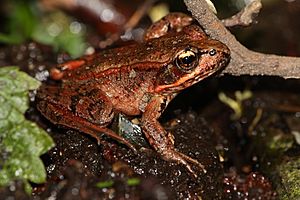Northern red-legged frog facts for kids
Quick facts for kids Northern red-legged frog |
|
|---|---|
 |
|
| Conservation status | |
| Scientific classification | |
| Genus: |
Rana
|
| Species: |
aurora
|
The northern red-legged frog (Rana aurora) is a type of amphibian. It lives along the coast from southwest British Columbia down to northern California. This frog is protected in Oregon and California.
As a true frog, it has smooth skin and a narrow body. These frogs need calm water for breeding. They usually stay close to their breeding ponds or marshes.
Adult northern red-legged frogs can grow up to 8 cm (3.1 in) long. They have dark markings on their faces. A light stripe runs along their jawlines. Their long, strong legs help them jump far. There are two types of red-legged frogs. The other is the California red-legged frog. It lives further south, from southern Mendocino County to Baja California.
Contents
Where do northern red-legged frogs live?
The northern red-legged frog lives in the Pacific Northwest. You can find it in western Oregon, western Washington, and southwest British Columbia. This includes Vancouver Island.
In California, it lives in all coastal counties from southern Mendocino County northwards. It mostly lives in the coastal mountains. But it is not found higher than 1200 meters (about 3,900 feet). It also lives in the southern Cascade Range, but less often.
What kind of habitat do these frogs need?
Northern red-legged frogs need calm water for breeding. This includes ponds, marshes, or quiet stream pools. They really like watery places with lots of plants along the shoreline.
These frogs need places to hide. Many animals hunt them. These include fish, snakes, birds, mammals, and even other amphibians. If a frog senses danger, it quickly dives deep. It will go one meter or more underwater to hide in the bottom mud.
Adult frogs leave their breeding ponds soon after laying eggs. They might travel about half a kilometer (about a third of a mile). They go to summer spots, often near rivers or streams. In colder areas, adults may hibernate in winter. Young frogs stay in the breeding ponds longer. They also find cover near water. They can travel about half a kilometer by summer.
Mature R. aurora frogs eat land insects. They also eat small snails and crustaceans. Their diet includes worms, tadpoles, small fish, and even small frogs of other species. The tadpoles are plant-eaters.
Northern red-legged frog reproduction and life cycle
Male and female frogs start moving to breeding spots early. This can be as early as October or as late as January. It depends on the location, how much rain has fallen, and the average temperature. Breeding usually starts when the temperature stays above 5.5 to 6.5 °C (42 to 44 °F).
It is easiest to see adults moving on moonlit nights when it is lightly raining. Male frogs may defend their space in the breeding pond. They do this with displays at night. Most of their activity happens at night, especially when it is raining lightly.
The actual courtship starts in January in California. It can be as late as March in northern areas. The breeding season ends by July at the latest. It ends earlier in drier places.
Each female frog lays 200 to 1100 eggs in one season. She attaches the egg cluster to plants or rotting logs underwater. The eggs are usually 7 to 15 cm (3 to 6 in) below the surface. Egg clusters are about 10 cm (4 in) wide. They can spread out underwater. Eggs hatch in 39 to 45 days. Tadpoles need about 80 days to change into frogs. This change is called metamorphosis.
Frogs usually lay eggs in shallow, plant-filled parts of wetlands. These areas have little water movement. Sometimes, egg masses are found in water up to 500 cm (16 feet) deep. Breeding spots can be permanent or temporary. The water usually needs to stay until June for tadpoles to fully change. In Northern California, this change happens in late May or early June. Breeding begins when water temperatures are above 6°C. This is usually in January, but can be as late as March in the far north.
See also
 In Spanish: Rana norteña de patas rojas para niños
In Spanish: Rana norteña de patas rojas para niños



